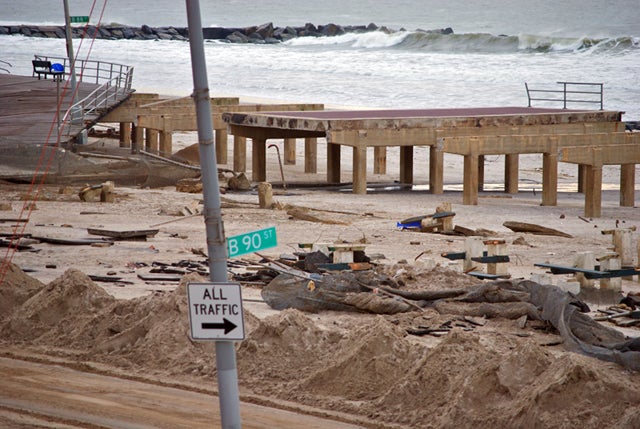Driving over the Marine Parkway-Gil Hodges Bridge toward the Rockaway Peninsula, the first discernable evidence of catastrophe is the half-mile wide mountain of rubble bulldozed atop the parking lot of Jacob Riis Park, a desolate sweep of sand, sea grass, and concrete that wraps the wiry tail of Long Island like a bandage. Heading east into Rockaway Beach, we glance nervously at the NYPD and National Guardsmen stationed at dead traffic lights, and at the men siphoning gas from abandoned cars strewn everywhere. On 87th, we cleave the guts of flooded homes and park beside a long procession of people queuing up for rations outside the Rockaway Surf Club, where founder of Waves For Water, Jon Rose, and a group of local surfers, anxiously wait.
 The scene on the Rockaway Peninsula, where Waves for Water has organized relief efforts.
The scene on the Rockaway Peninsula, where Waves for Water has organized relief efforts. The scene on the Rockaway Peninsula, where Waves for Water has organized relief efforts.
The scene on the Rockaway Peninsula, where Waves for Water has organized relief efforts. The scene on the Rockaway Peninsula, where Waves for Water has organized relief efforts.
The scene on the Rockaway Peninsula, where Waves for Water has organized relief efforts.��
“Glad to see you made it,” Rose says, behind him the grimy brick walls of the club, accented with a surfing-inspired calavera mural. “We were wondering how a trip into New York City with a thousand-pound gas bomb would go over with Homeland Security.”
Earlier that morning, professional surfer Andrew Gesler and I met in his hometown of Ocean City—a Southern New Jersey barrier island also hit hard by Sandy—where we loaded six 25-gallon containers of fuel into the back of an unmarked pick-up, grounded the tanks with jumper cables, tarped the cargo, and made the tense three-hour trip up the Garden State Parkway and into New York City.
It was a dangerous and not-quite-legal mission, but it was just the kind of maneuver that fits Rose’s “guerilla humanitarianism” philosophy—a style he adopted in the days following the 2009 earthquake in Padang, Indonesia, when, as a one-man show, he pulled together key community members to distribute portable water filters, ultimately saving thousands of lives and launching the non-profit .
“Indonesia was a very tangible experience,” says Rose. “I made a lot of impact in a short amount of time and it just clicked. I knew this guerilla mentality that comes naturally to athletes, travelers, and adventurers—like surfers—could be replicated and implemented around the world.”
Andrew Gesler is just one in a groundswell of volunteer surfers from New Jersey and New York’s tight-knit beach communities who have joined Rose’s team, using close relationships up and down the coast, as well as a fearlessness nurtured by a career chasing waves, to quickly build the (Waves for Water’s first disaster relief mission on U.S. soil) into a strikingly efficient operation.
“My life is pretty much about taking risks,” Gesler tells me later. “I’ve encountered the word ‘can’t’ so many times, like, ‘You’re a surfer from New Jersey, you can’t surf the best waves in the world’ or ‘You can’t make a living out of this.’ If you tell me I’m not allowed or can’t do something, I’m going to figure out a way to prove you wrong.”
Another renowned Jersey pro, Sam Hammer, has also been quick on his feet since waking up on October 30 and discovering that parts of his beloved surf stomping grounds in Bay Head, Mantoloking, Lavallette, and Seaside Heights had been literally washed away. When the National Guard evacuated the island due to exploding gas lines, failed roads and bridges, and looting, Hammer redirected and rushed to get supplies into Staten Island, where 30-foot fishing boats were deposited several blocks inland and thousands of residents wandered the streets in need of basic goods like toiletries and cleaning supplies.
“In the water surfers butt heads—we can be greedy,” says Hammer. “But when this disaster hit us, we stepped up together and got things done. It’s incredible how fast [Rose’s] initiative came to fruition.”
In Staten Island, the Rockaways, Long Beach, and the crippled Central Jersey Shore towns, tens of thousands of people are facing the grim prospect of being short on fuel, without power, or homeless for many more weeks and even months. The widespread duress has left the Red Cross and FEMA stretched thin—their size, often an asset, becoming a hindrance. But the quick-thinking tactics of Jon Rose and other hyper-local organizations like —and the urgency of surfers like Gesler and Hammer—are getting food, fuel, and other necessities to overlooked neighborhoods today, rather than tomorrow, next week, or next month.
“Surfers are naturally very driven,” says Rose. “A lot of times you have to solve a number of problems just to get to a remote surf break. You have to develop a sense of resourcefulness and have the courage to navigate through difficult situations. Surfers, mountaineers, adventurers—we go toward danger rather than run from it, and that quality naturally makes us better at things like disaster relief.”
Since arriving from California on November 3, Rose has set up two warehouse hubs in New Jersey and New York, as well as six local distribution points, like Rockaway Beach Surf Club, that are brimming with donations. On top of that, Waves for Water has raised $165,000 for long-term relief and rebuilding efforts, some of which has come from 11-time world surfing champion Kelly Slater and singer/songwriter Jack Johnson. “All of these experiences I’ve had as a surfer,” Rose explains, “I pull from them every day in this work.”
JUST AFTER DUSK, WE are down to our last 30 gallons of fuel. There are stars, finally, hanging above the hulking silhouettes of Rockaway’s powerless apartment blocks, but the temperature is scratching at freezing and rain is in tomorrow’s forecast. A curfew is in effect and the streets are barren and dark, allowing for an uneasy mood to roam the night.
On 96th Street, we arrive at a large white tent—the kind you’d find at a wedding—glowing atop a muddy, empty lot squeezed between two redbrick high-rises. We’ve come for Michelle Cortez, who I find seated at a picnic table in a far corner of the tent, surrounded by take-out containers and relaying instructions into a glowing iPhone. While the generator she has acquired is humming outside and powering our light for now, her fuel cache is running low. When she hangs up, I ask her what this huge, empty shelter is for.
“Anything,” Michelle says, her steady New York accent betrayed by worried green eyes. “We put it up earlier today for people around here to come to. To sleep. To eat. To get out of the dark. Anything.”
We fill Cortez’s gas cans, then help her carry them across the street and into the living room of a vacant apartment. Inside, the air is stale and bathed in a faint blue light that freezes furniture and photos hanging on molding walls exactly as they were when, three weeks ago, the Atlantic Ocean and Jamaica Bay surged together and changed Rockaway Beach forever.
Back at the tent, we huddle around Gelser’s pick-up truck, all of us shivering and reeking of fuel, and pass around Rose’s compulsory flask of Johnny Walker—the same one that’s accompanied him in the tough days, months, and years after disasters in Indonesia, Japan, Pakistan, and Haiti. Standing there, with the heat of the whiskey in my mind, I cannot help but feel like we have stumbled into a McCarthyian post-apocalypse. “Perhaps in the world’s destruction it would be possible at last to see how it was made. Oceans, mountains. The ponderous counterspectacle of things ceasing to be. The sweeping waste, hydroptic and coldly secular. The silence,” the Man thought in The Road.
This is Cormac McCarthy’s ponderous counterspectacle defined. The same force of nature that surfers around here rely on to feed their addiction to riding waves has ripped away the very beaches where they fled to get their fix. The ocean had revolted against them, yet the bond it created between them long ago was not only left unmarred, it was made stronger. This is no Haiti, but, like Rose’s effort there, it’s going to take days, months, and years to get this coast back to a semblance of what it was.
“There’s no doubt that here in the U.S. it’s more challenging because of bureaucracy,” says Rose, contemplating the long road ahead. “But sometimes you have to go out on the edge a little bit to get things done. That’s the point of this work, right? To look back on days like today and know that you charged, got it done, and helped make people better off.”


